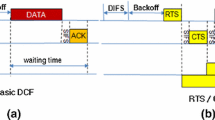Abstract
In this paper, we propose a novel slotted Dual-Channel Reservation (DCR) MAC protocol that uses 802.11 primitives for providing both Quality of Service (QoS) and fairness. RTS/CTS handshaking is transmitted on a separated control channel to prevent successive collisions of RTS and CTS packets with existing data transmission. Furthermore, contention for channel access may be initiated by sender as well as receiver depending on the channel status for better fairness. A simple slot reservation algorithm in the data channel provides high efficiency. The main conclusion is that reservation access benefits both delay performance, and efficiency as well as fairness—the reason being that not only an exposed terminal can regain the channel more easily because of dramatically reduced contention (RTS-CTS) traffic, but also a hidden terminal receives less collisions in handshaking since any node winning a slot will quit contending on the control channel. Therefore, it is highly recommended to use reservation access even if the prevailing traffic is data, e.g. TCP. To enhance delay performance, we devise a fake packet repeating mechanism that can reserve the slot for a connection even if the user temporarily has no packets to transmit. Simulations based on key metrics—throughput, fairness index and mean delay are performed to validate the new protocol and quantify its advantages. The limitations of the proposed DCR-802.11 protocol due to need for global clock synchronization and dual channels are also discussed.
Similar content being viewed by others
References
V. Bharghavan, A. Demers, S. Shenker and L. Zhang, MACAW: A media access protocol for wireless LANs, in: Proc. of ACM SIGCOMM’94, 1994.
G. Bianchi, Performance analysis of the IEEE 802.11 distributed coordination function, IEEE JSAC, 28(3) (2000) 535–547.
E.A. Bretz and T.S. Perry, X marks the spot, maybe, IEEE Spectrum, 37 (2000) 26–36.
B.P. Crow and J.G. Kim, IEEE 802.11 wireless local area networks, IEEE Comm. Mag., Sept. 1999.
Sim Eleven, An IEEE 802.11 MATLAB-based Simulator, Available at: http//netlab1.bu.edu/saikat.
Z.J. Hass and J. Deng, Dual busy tone multiple access (DBTMA)—A multiple access control scheme for ad hoc networks, IEEE Trans. Comm. 5(6) (2002) 975–985 .
IEEE Standard for Wireless LAN Medium Access Control (MAC) and Physical Layer (PHY) sepcifications, ISO/IEC 8802–11: 1999(E) (Aug. 1999).
S. Jiang, J. Rao, D. He and X. Ling, A simple distributed PRMA for MANETs, IEEE Trans. on Vehi. Tech., 51(2), 293–305.
L. Krishnamurthy, S. Conner, M. Yarvis, J. Chhabra, C. Ellison, C. Brabenac and E. Tsui, Meeting the demonds of the digital home with high-speed multi-hop wireless networks, Intel Technology Journal, 6(4) (Nov. 15, 2002).
J. Li, C. Blake, D.S.J. De Couto, H.I. Lee and R. Morris, Capacity of ad hoc wireless networks, 7th ACM Mobilecom, 2001.
C.H.R. Lin and M. Gerla, Asychronous multimedia multihop radio network, in: Proc. IEEE INFOCOM, Kobe, Japan (Apr. 7–11, 1997) pp. 118–125.
S. Mangold, S. Choi, P. May, O. Klein, G. Hiertz and L. Stibor, IEEE 802.11e Wireless LAN for Quality of Service, European Wireless ‘2002, Florence, Italy, Feb. 2002.
D. Qiao and K.G. Shin, Achieving efficient channel utilization and weighted fairness for data communications in IEEE802.11 WLAN under the DCF, the 10th ieee international workshop on qos, (2002) pp. 227–236.
S. Ray, J.B. Carruthers and D. Starobinski, RTS/CTS-Induced Congestion in Ad Hoc Wireless LANs, IEEE WCNC2003, New Orleans, Lousiana, USA, 16–20 March 2003.
M. Schwartz, Broadband Integrated Networks (Prentice Hall, 1998).
M. Schwartz, Broadband Integrated Networks (Prentice Hall, Inc., 1998).
Y. Wang and B. Bensaou, Achieving fairness in IEEE802.11 DFWMAC with variable packet lengths, IEEE GLOBECOM ‘01. 6(2001) 3588–3593.
Y. Xiao and J. Rosdahl, Throughput and delay limits of IEEE802.11, IEEE Comm. Letter, 6(8) (Aug. 2002).
S. Xu and T. Saadawi, Does the IEEE 802.11 MAC protocol work well in multihop wireless Ad hoc networks, IEEE Comm. Mag., June, 2001.
Author information
Authors and Affiliations
Corresponding author
Additional information
Jing Zhu received the B.S. and M.Sc. degrees both in electronic engineering from Tsinghua University, Beijing, P. R. China, in 2000 and 2001, respectively, and Ph.D. in electrical engineering from University of Washington (Seattle) in 2004. Currently, he is a research scientist in the Communications Technology Lab at Intel Corp. He is an IEEE member. His main research interest is high-performance wireless networking and its applications, e.g. Internet-on-Move, Digital Home, and Intelligent Transport System, focusing on cross-layer protocol optimization.
Sumit Roy received the B. Tech. degree from the Indian Institute of Technology (Kanpur) in 1983, and the M. S. and Ph. D. degrees from the University of California (Santa Barbara), all in Electrical Engineering in 1985 and 1988 respectively, as well as an M. A. in Statistics and Applied Probability in 1988. His previous academic appointments were at the Moore School of Electrical Engineering, University of Pennsylvania, and at the University of Texas, San Antonio. He is presently Prof. of Electrical Engineering, Univ. of Washington where his research interests center around analysis/design of physical and data link layer of communication systems, with a topical emphasis on next generation mobile/wireless networks. He is currently on academic leave at Intel Wireless Technology Lab working on high speed UWB radios and next generation Wireless LANs. His activities for the IEEE Communications Society includes membership of several technical committees and technical program committees for conferences, and he serves as an Editor for the IEEE Transactions on Wireless Communications and Wiley Journal on Wireless Communications and Mobile Computing.
Rights and permissions
About this article
Cite this article
Zhu, J., Roy, S. A 802.11 Based Slotted Dual-Channel Reservation MAC Protocol for In-Building Multi-Hop Networks. Mobile Netw Appl 10, 593–606 (2005). https://doi.org/10.1007/s11036-005-3355-x
Issue Date:
DOI: https://doi.org/10.1007/s11036-005-3355-x




